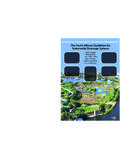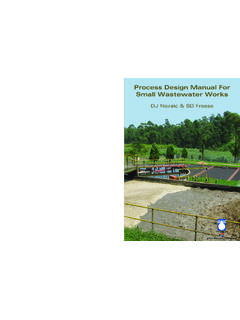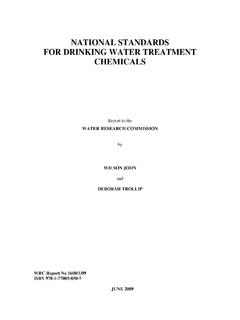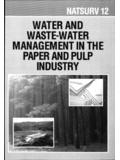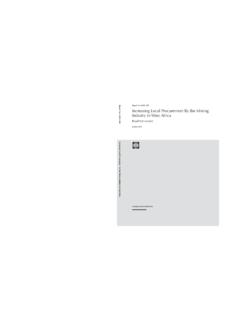Transcription of 24 WATER RECLAMATION - WRC Home
1 24 The WATER Wheel July/August 2003 WATER RECLAMATIONL eading edge process techno-logy was integrated into thedesign of the new 21 Ml/dGoreangab WATER ReclamationPlant, which was completed in is internationally renowned as thefirst plant in the world to reclaimdomestic sewage for drinking waterpurposes. After 32 years it contin-ues to be the only plant in theworld to do RAW WATERRESOURCESN amibia is the most arid country inSouthern Africa and continuouslyfaces serious WATER initial Goreangab WATER Recla-mation Plant was built by the Cityof Windhoek in 1968 to reclaimwater directly from domestic sew-age effluent as a supplement toWindhoek s very scarce raw waterresources.
2 The plant can be fedfrom two sources, these being theGammams Sewage Treatment Plantand the Goreangab Dam. The rawwaters are blended and treated as asingle stream. In general, the objec-tive is to utilise a larger portion ofthe effluent from the sewage treat-ment plant than WATER from theGoreangab Goreangab WATER RECLAMATION Plant in Windhoek is internationally renowned as the firstand only plant in the world to reclaim domestic sewage for potable use as a supplement toWindhoek s very scarce raw WATER WATER Wheel July/August 2003 WATER RECLAMATIONHEALTH CONCERNSDue to pollution in the catchmentarea of the dam.
3 The quality of thewater had deteriorated over theyears to such an extent that con-ventional treatment methods couldno longer be applied. The twosources had to be combined andtreated in a single extended andupgraded new Goreangab WaterReclamation the early nineties, the needarose to augment the plant signifi-cantly and to upgrade its treatmenttrain with the latest technology toaddress the most recent , South African consulting engi-neers, formed a consortium withFichtner in Germany and Multi-Consult in Namibia and the FMGG oreangab Joint Venture was awardedthe technical responsibility for thischallenging TECHNOLOGYS ince the commissioning of the firstreclamation plant in 1968 a hugeamount of new information onvarious aspects of WATER treatmentbecame known.
4 Experience ob-tained from the old plant, informa-tion from pilot plant studies andThe original WATER RECLAMATION plant in Windhoek was developed by the National Institute for WATER Re-search (NIWR) of the Council for Scientific and Industrial Research (CSIR) during the 1960s. The designand operation was based on the results of a pilot plant operated by the NIWR in Windhoek over the period1964 to the WATER Research Commission (WRC) was established in 1971 it immediately embarked on an ambi-tious research programme to expedite the development of the technology of WATER RECLAMATION and to studythe health effects of such research facility was constructed by the CSIR at Daspoort WATER treatment works in Pretoria and theWindhoek plant was modified from time to time to incorporate advantages gained from the latest researchresults with financial assistance from the WATER Research 1976 the Windhoek plant was upgraded and extended.
5 Again with financial support by the WRC. At the inau-guration ceremony Dr GJ Stander, the then chairman of the WRC, stressed the significance and the value of theground-breaking research at Windhoek with a quotation from an American scientist who (at a conference in1969) said: Windhoek will become famous as the first city in the world to reclaim wastewater on a regular basis fordirect domestic reuse. This plant has been in operation since spring 1969 and the peoples of the world have taken littlenotice of its existence.
6 Yet, in this same year that saw science and engineering land a human on the face of the moon, science and engineeringalso brought direct WATER reuse into reality. The question is, which event will have more intimate impact on our lives andthose of our children? LOOKING BACK AT THE WATER Wheel July/August 2003 WATER RECLAMATION knowledge of current technologieshad to be integrated into a processdesign which eventually lead to areclamation Plant producing waterof a final quality which is sustainablyfit for human ANDDEVELOPMENTThe new treatment plant was de-signed using data from 400 days ofpilot testing and a comprehensivereview of international research and development partof the project played an importantrole in eventually determining theprocess train
7 And establishing im-portant design parameters. In thisregard, research was focused on theoptimal removal of organics andharmful pathogens from the was achieved by operating anozone/activated carbon pilot plant, amembrane pilot plant and perform-ing some full-scale studies on theold plant with regard to the precipi-tation of organics at various the research part of theproject, WATER quality concernswere categorised into the following:6 Physical and Organoleptic6 Macro Elements6 Microbiological6 Disinfection By-productsBARRIERSThe process design was one of a multiple barrier process whereindividual barriers were establishedfor each of the groups mentionedabove.
8 With a major emphasis be-ing placed on a safe final product,three barriers were set for patho-gens like Cryptosporidium and reduction in organic contentbefore chlorination to reduce theformation of trihalomethanes (po-tentially carcinogenic) also necessi-tated three barriers. Employing thisapproach for each concern wouldensure a final WATER complying withthe stringent standards the establishment of adesign philosophy, the processesrequired to create the multiplebarriers had to be identified andsequenced into a final process de-sign.
9 The old plant was taken as astarting point for processes cur-rently employed and a detailedevaluation of the existing plant indi-cated that the old treatment traincomfortably provided one treat-ment barrier against physical andorganoleptic parameters throughDissolved Air Flotation (DAF), set-tling, and filtration and two barriersagainst most microbiological andbiological parameters (two chlorina-tion steps).To enhance the multiple barrierconcept further, the following spe-cific adaptations and additions tothe original process were imple-mented:6 Powdered Activated carbon (PAC) dosing, should one of theThe High Lift Pumping Station consists of two pumpsets.
10 The pumping stationfurther houses the raw waterpumps with the raw WATER inlet works to theright of the pumps, just below the clear WATER reservoir. Several on-lineinstruments are situated in the building for quality control WATER Wheel July/August 2003 WATER RECLAMATIONkey processes such as ozone,membrane or Granular Acti-vated carbon (GAC) filtrationfail. This process will only be anoperational settling step was shown toadd very little benefit to thephase separation alreadyachieved by DAF and could beexcluded without any compro-mise to the overall plant was added as an addi-tional step before GAC for itsability to destroy cysts, particu-larly Giardia and Cryptosporidium.
